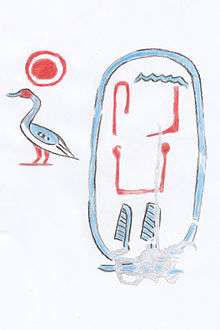Senebkay
Woseribre Senebkay (alternatively Seneb Kay) was an ancient Egyptian pharaoh during the Second Intermediate Period. The discovery of his tomb in January 2014 supports the existence of an independent Abydos Dynasty, contemporary with the Fifteenth and Sixteenth Dynasties during the Second Intermediate Period.[2] He might also appear in the Turin Canon, where there appear two kings with the throne name "Weser... re" (the names are only partly preserved). A further possible object with his name is a magical wand bearing the name Sebkay. The wand was found at Abydos but could refer to one or possibly two kings of the earlier 13th Dynasty.[3] The existence of the so-called Abydos Dynasty was first proposed by Detlef Franke[4] and later further developed by Kim Ryholt in 1997.[2]
| Senebkay | ||||||||||||||||||||||||||
|---|---|---|---|---|---|---|---|---|---|---|---|---|---|---|---|---|---|---|---|---|---|---|---|---|---|---|
| Seneb Kay | ||||||||||||||||||||||||||
 Drawing of Senebkay's cartouche | ||||||||||||||||||||||||||
| Pharaoh | ||||||||||||||||||||||||||
| Reign | c. 1650 BC (uncertain, Abydos Dynasty or 16th Dynasty) | |||||||||||||||||||||||||
| Predecessor | ? | |||||||||||||||||||||||||
| Successor | ? | |||||||||||||||||||||||||
| ||||||||||||||||||||||||||
| Burial | Abydos, tomb CS9 | |||||||||||||||||||||||||
Tomb

Senebkay's tomb (CS9) was discovered in 2014 by Josef W. Wegner of the University of Pennsylvania and a team of Egyptian archaeologists in the southern part of Abydos, Egypt.[5][6] The four-chamber tomb has a decorated limestone burial chamber. Most blocks of the chamber were reused from older structures, such as the stela of Idudju-iker. On the east, short wall there is a painted depiction of the two Wadjet-eyes. Left and right are standing the goddess Neith and Nut. Over the scene is depicted a winged sun disc. On the North wall is depicted a standing goddess; her name is destroyed. There are short text lines mentioning the deities Duamutef and Qebehsenuf. In the center of the wall appears the cartouche with the king's name Senebkay. The South wall is much destroyed. There are visible the remains of two female deities. Texts mention the deities Amset and Hapi.[7] The head of the king was once decorated with a mummy mask.[8] The texts record the pharaoh's titulary and call him the "king of Upper and Lower Egypt, Woseribre, the son of Re, Senebkay".[2] Senebkay's name was found inscribed inside a royal cartouche. Some of the burial equipment, such as the wooden canopic box, were taken from older tombs. The remains of the canopic box was originally inscribed for a king Sobekhotep,[8] likely from the nearby tomb S10, now believed to belong to Sobekhotep IV.[9]
The tomb did not house many funerary goods and may have been robbed in ancient times.[10] The king was around 5 feet 10 inches (1.78 metres) tall and died between the ages of 35 and 40.[11] Studies on his skeleton reveal he was most likely killed in battle. There are eighteen wounds on his bones, impacting his lower back, feet and ankles. The cutting angles suggest he was hit from below, perhaps while he was on a chariot or on horseback. Upon falling to the ground, he was killed by several axe blows to the skull. The curvature of the wounds on the skull indicate the use of battle axes contemporary to the Second Intermediate Period.[11]
References
| Wikimedia Commons has media related to Senebkay. |
- J. Wegner: A Royal Necropolis at Abydos, in: Near Eastern Archaeology, 78 (2), 2015, p. 74 Fig. 9 (name in original without cartouche)
- "Giant Sarcophagus Leads Penn Museum Team in Egypt To the Tomb of a Previously Unknown Pharaoh". Penn Museum. January 2014. Retrieved 16 January 2014.
- finding-a-lost-pharaoh Archived 28 January 2014 at Archive.today archaeology and arts Retrieved 28 Jan 2014
- Franke, Detlef (1988). "Zur Chronologie des Mittleren Reiches. Teil II: Die sogenannte Zweite Zwischenzeit Altägyptens". Orientalia. 57: 259.
- Mintz, Zoe (15 January 2014). "New Pharaoh Discovered In Egypt, King Seneb Kay Had 'The Longest Rule' Of His Time". International Business Times.
- The Associated Press (15 January 2014). "New Pharaonic Tomb Discovered in Egypt". Cairo: ABC News.
- Josef Wegner: Raise yourself up: Mortuary Imaginary in the Tomb of Woseribre Seneb-Kay, in: G. Miniaci, M. Betrò, S. Quirke (editors): Company of Images, Modelling the Imaginary World of Middle Kingdom Egypt (2000-1500 BC), (Orientalia Lovaniensia Analecta 262), Leuven, Paris, Bristol, CT, 2017, ISBN 978-90-429-3495-5, pp. 485-487.
- Josef Wegner: Kings of Abydos, solving an Ancient Egyptian Mystery, in: Current World Archaeology, Magazine, 64, April/May 2014, Volume 6, no. 4, p. 26
- Wegner, Josef W. (2015). "A royal necropolis at south Abydos: New Light on Egypt's Second Intermediate Period". Near Eastern Archaeology. 78 (2): 69–70. See p. 70
- Holloway, April (15 January 2014). "New Pharaoh Discovered In Egypt – Introducing King Seneb Kay". Ancient Origins. Retrieved 16 January 2014.
- Lorenzi, Rossella (25 February 2015). "Pharaoh Brutally Killed in Battle, Analysis Shows". Discovery.